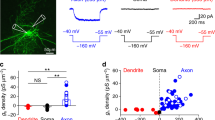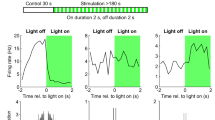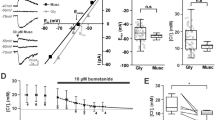Abstract
Hippocampal GABAergic interneurons show diverse molecular and morphological properties. The functional significance of this diversity for information processing is poorly understood. Here we show that cholecystokinin (CCK)-expressing interneurons in rat dentate gyrus release GABA in a highly asynchronous manner, in contrast to parvalbumin (PV) interneurons. With a gamma-frequency burst of ten action potentials, the ratio of asynchronous to synchronous release is 3:1 in CCK interneurons but is 1:5 in parvalbumin interneurons. N-type channels trigger synchronous and asynchronous release in CCK interneuron synapses, whereas P/Q-type Ca2+ channels mediate release at PV interneuron synapses. Effects of Ca2+ chelators suggest that both a long-lasting presynaptic Ca2+ transient and a large distance between Ca2+ source and sensor of exocytosis contribute to the higher ratio of asynchronous to synchronous release in CCK interneuron synapses. Asynchronous release occurs at physiological temperature and with behaviorally relevant stimulation patterns, thus generating long-lasting inhibition in the brain.
This is a preview of subscription content, access via your institution
Access options
Subscribe to this journal
Receive 12 print issues and online access
$209.00 per year
only $17.42 per issue
Buy this article
- Purchase on SpringerLink
- Instant access to full article PDF
Prices may be subject to local taxes which are calculated during checkout








Similar content being viewed by others
References
Lisman, J.E. Relating hippocampal circuitry to function: recall of memory sequences by reciprocal dentate–CA3 interactions. Neuron 22, 233–242 (1999).
Freund, T.F. & Buzsáki, G. Interneurons of the hippocampus. Hippocampus 6, 347–470 (1996).
McBain, C.J. & Fisahn, A. Interneurons unbound. Nat. Rev. Neurosci. 2, 11–23 (2001).
Miles, R., Tóth, K., Gulyás, A.I., Hájos, N. & Freund, T.F. Differences between somatic and dendritic inhibition in the hippocampus. Neuron 16, 815–823 (1996).
Cobb, S.R., Buhl, E.H., Halasy, K., Paulsen, O. & Somogyi, P. Synchronization of neuronal activity in hippocampus by individual GABAergic interneurons. Nature 378, 75–78 (1995).
Buzsáki, G. & Draguhn, A. Neuronal oscillations in cortical networks. Science 304, 1926–1929 (2004).
Mitchell, S.J. & Silver, R.A. Shunting inhibition modulates neuronal gain during synaptic excitation. Neuron 38, 433–445 (2003).
Holt, G.R. & Koch, C. Shunting inhibition does not have a divisive effect on firing rates. Neural Comput. 9, 1001–1013 (1997).
Datyner, N.B. & Gage, P.W. Phasic secretion of acetylcholine at a mammalian neuromuscular junction. J. Physiol. (Lond.) 303, 299–314 (1980).
Isaacson, J.S. & Walmsley, B. Counting quanta: direct measurements of transmitter release at a central synapse. Neuron 15, 875–884 (1995).
Kraushaar, U. & Jonas, P. Efficacy and stability of quantal GABA release at a hippocampal interneuron–principal neuron synapse. J. Neurosci. 20, 5594–5607 (2000).
Hefft, S., Kraushaar, U., Geiger, J.R.P. & Jonas, P. Presynaptic short-term depression is maintained during regulation of transmitter release at a GABAergic synapse in rat hippocampus. J. Physiol. (Lond.) 539, 201–208 (2002).
Bartos, M. et al. Fast synaptic inhibition promotes synchronized gamma oscillations in hippocampal interneuron networks. Proc. Natl. Acad. Sci. USA 99, 13222–13227 (2002).
Goda, Y. & Stevens, C.F. Two components of transmitter release at a central synapse. Proc. Natl. Acad. Sci. USA 91, 12942–12946 (1994).
Jensen, K., Lambert, J.D.C. & Jensen, M.S. Tetanus-induced asynchronous GABA release in cultured hippocampal neurons. Brain Res. 880, 198–201 (2000).
Otsu, Y. et al. Competition between phasic and asynchronous release for recovered synaptic vesicles at developing hippocampal autaptic synapses. J. Neurosci. 24, 420–433 (2004).
Atluri, P.P. & Regehr, W.G. Delayed release of neurotransmitter from cerebellar granule cells. J. Neurosci. 18, 8214–8227 (1998).
Lu, T. & Trussell, L.O. Inhibitory transmission mediated by asynchronous transmitter release. Neuron 26, 683–694 (2000).
Rumpel, E. & Behrends, J.C. Sr2+-dependent asynchronous evoked transmission at rat striatal inhibitory synapses in vitro. J. Physiol. (Lond.) 514, 447–458 (1999).
Xu-Friedman, M.A. & Regehr, W.G. Presynaptic strontium dynamics and synaptic transmission. Biophys. J. 76, 2029–2042 (1999).
Morozov, Y.M. & Freund, T.F. Postnatal development and migration of cholecystokinin-immunoreactive interneurons in rat hippocampus. Neuroscience 120, 923–939 (2003).
Freund, T.F. Interneuron diversity series: Rhythm and mood in perisomatic inhibition. Trends Neurosci. 26, 489–495 (2003).
Pawelzik, H., Hughes, D.I. & Thomson, A.M. Physiological and morphological diversity of immunocytochemically defined parvalbumin- and cholecystokinin-positive interneurones in CA1 of the adult rat hippocampus. J. Comp. Neurol. 443, 346–367 (2002).
Maccaferri, G., Roberts, J.D.B., Szucs, P., Cottingham, C.A. & Somogyi, P. Cell surface domain specific postsynaptic currents evoked by identified GABAergic neurones in rat hippocampus in vitro. J. Physiol. (Lond.) 524, 91–116 (2000).
van der Kloot, W. Estimating the timing of quantal releases during end-plate currents at the frog neuromuscular junction. J. Physiol. (Lond.) 402, 595–603 (1988).
Diamond, J.S. & Jahr, C.E. Asynchronous release of synaptic vesicles determines the time course of the AMPA receptor-mediated EPSC. Neuron 15, 1097–1107 (1995).
Hamann, M., Rossi, D.J. & Attwell, D. Tonic and spillover inhibition of granule cells control information flow through cerebellar cortex. Neuron 33, 625–633 (2002).
Heinemann, S.H. & Conti, F. Nonstationary noise analysis and application to patch clamp recordings. Methods Enzymol. 207, 131–148 (1992).
Jones, M.V. & Westbrook, G.L. Desensitized states prolong GABAA channel responses to brief agonist pulses. Neuron 15, 181–191 (1995).
Brickley, S.G., Cull-Candy, S.G. & Farrant, M. Single-channel properties of synaptic and extrasynaptic GABAA receptors suggest differential targeting of receptor subtypes. J. Neurosci. 19, 2960–2973 (1999).
Poncer, J.C., McKinney, R.A., Gähwiler, B.H. & Thompson, S.M. Either N- or P-type calcium channels mediate GABA release at distinct hippocampal inhibitory synapses. Neuron 18, 463–472 (1997).
Wilson, R.I., Kunos, G. & Nicoll, R.A. Presynaptic specificity of endocannabinoid signaling in the hippocampus. Neuron 31, 453–462 (2001).
Randall, A. & Tsien, R.W. Pharmacological dissection of multiple types of Ca2+ channel currents in rat cerebellar granule neurons. J. Neurosci. 15, 2995–3012 (1995).
Rozov, A., Burnashev, N., Sakmann, B. & Neher, E. Transmitter release modulation by intracellular Ca2+ buffers in facilitating and depressing nerve terminals of pyramidal cells in layer 2/3 of the rat neocortex indicates a target cell-specific difference in presynaptic calcium dynamics. J. Physiol. (Lond.) 531, 807–826 (2001).
Neher, E. Usefulness and limitations of linear approximations to the understanding of Ca++ signals. Cell Calcium 24, 345–357 (1998).
Meinrenken, C.J., Borst, J.G.G. & Sakmann, B. Calcium secretion coupling at calyx of Held governed by nonuniform channel-vesicle topography. J. Neurosci. 22, 1648–1667 (2002).
Wu, L.G., Westenbroek, R.E., Borst, J.G.G., Catterall, W.A. & Sakmann, B. Calcium channel types with distinct presynaptic localization couple differentially to transmitter release in single calyx-type synapses. J. Neurosci. 19, 726–736 (1999).
Bragin, A. et al. Gamma (40–100 Hz) oscillation in the hippocampus of the behaving rat. J. Neurosci. 15, 47–60 (1995).
Matsui, K. & Jahr, C.E. Differential control of synaptic and ectopic vesicular release of glutamate. J. Neurosci. 24, 8932–8939 (2004).
Atluri, P.P. & Regehr, W.G. Determinants of the time course of facilitation at the granule cell to Purkinje cell synapse. J. Neurosci. 16, 5661–5671 (1996).
Verhage, M. et al. Differential release of amino acids, neuropeptides, and catecholamines from isolated nerve terminals. Neuron 6, 517–524 (1991).
Schmidt, H., Stiefel, K.M., Racay, P., Schwaller, B. & Eilers, J. Mutational analysis of dendritic Ca2+ kinetics in rodent Purkinje cells: role of parvalbumin and calbindin D28k . J. Physiol. (Lond.) 551, 13–32 (2003).
Collin, T. et al. Developmental changes in parvalbumin regulate presynaptic Ca2+ signaling. J. Neurosci. 25, 96–107 (2005).
Südhof, T.C. Synaptotagmins: why so many? J. Biol. Chem. 277, 7629–7632 (2002).
Hui, E. et al. Three distinct kinetic groupings of the synaptotagmin family: candidate sensors for rapid and delayed exocytosis. Proc. Natl. Acad. Sci. USA 102, 5210–5214 (2005).
Pouille, F. & Scanziani, M. Routing of spike series by dynamic circuits in the hippocampus. Nature 429, 717–723 (2004).
Chance, F.S., Abbott, L.F. & Reyes, A.D. Gain modulation from background synaptic input. Neuron 35, 773–782 (2002).
Losonczy, A., Biró, A.A. & Nusser, Z. Persistently active cannabinoid receptors mute a subpopulation of hippocampal interneurons. Proc. Natl. Acad. Sci. USA 101, 1362–1367 (2004).
Neher, E. & Sakaba, T. Estimating transmitter release rates from postsynaptic current fluctuations. J. Neurosci. 21, 9638–9654 (2001).
Zhang, L. & McBain, C.J. Potassium conductances underlying repolarization and afterhyperpolarization in rat CA1 hippocampal interneurones. J. Physiol. (Lond.) 488, 661–672 (1995).
Acknowledgements
We thank J. Bischofberger for support at the confocal microscope and for many discussions; I. Vida and A. Kulik for help with immunocytochemistry; M. Bartos, J. Behrends, J. Bischofberger, K. Haverkampf and M. Heckmann for reading the manuscript and K. Winterhalter and M. Northemann for excellent technical assistance. Supported by the Deutsche Forschungsgemeinschaft (SFB 505, project C5).
Author information
Authors and Affiliations
Corresponding author
Ethics declarations
Competing interests
The authors declare no competing financial interests.
Rights and permissions
About this article
Cite this article
Hefft, S., Jonas, P. Asynchronous GABA release generates long-lasting inhibition at a hippocampal interneuron–principal neuron synapse. Nat Neurosci 8, 1319–1328 (2005). https://doi.org/10.1038/nn1542
Received:
Accepted:
Published:
Issue Date:
DOI: https://doi.org/10.1038/nn1542
This article is cited by
-
Robust Resting-State Dynamics in a Large-Scale Spiking Neural Network Model of Area CA3 in the Mouse Hippocampus
Cognitive Computation (2023)
-
Functional Autapses Form in Striatal Parvalbumin Interneurons but not Medium Spiny Projection Neurons
Neuroscience Bulletin (2023)
-
Normalized unitary synaptic signaling of the hippocampus and entorhinal cortex predicted by deep learning of experimental recordings
Communications Biology (2022)
-
The role of inhibitory circuits in hippocampal memory processing
Nature Reviews Neuroscience (2022)
-
Asynchronous glutamate release is enhanced in low release efficacy synapses and dispersed across the active zone
Nature Communications (2022)



